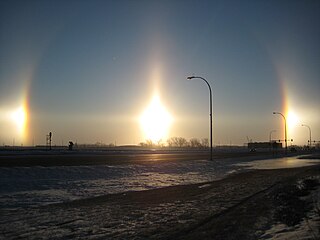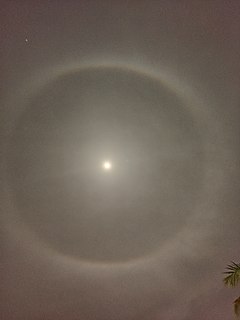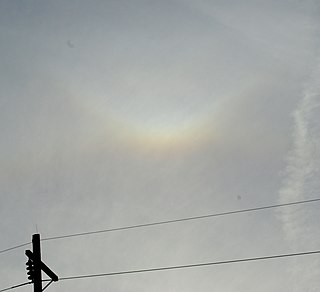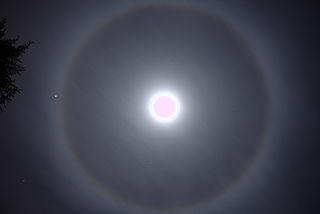Related Research Articles

The green flash and green ray are meteorological optical phenomena that sometimes occur transiently around the moment of sunset or sunrise. When the conditions are right, a distinct green spot is briefly visible above the upper rim of the Sun's disk; the green appearance usually lasts for no more than two seconds. Rarely, the green flash can resemble a green ray shooting up from the sunset or sunrise point.

A mirage is a naturally occurring optical phenomenon in which light rays bend via refraction to produce a displaced image of distant objects or the sky. The word comes to English via the French (se) mirer, from the Latin mirari, meaning "to look at, to wonder at".

Sunrise is the moment when the upper rim of the Sun appears on the horizon in the morning. The term can also refer to the entire process of the solar disk crossing the horizon and its accompanying atmospheric effects.

Sunset, also known as sundown, is the daily disappearance of the Sun below the horizon due to Earth's rotation. As viewed from everywhere on Earth, the equinox Sun sets due west at the moment of both the Spring and Autumn equinox. As viewed from the Northern Hemisphere, the sun sets to the northwest in the Northern hemisphere's spring and summer, and to the southwest in the autumn and winter; these seasons are reversed for the Southern Hemisphere.

A sun dog or mock sun, also called a parhelion in meteorology, is an atmospheric optical phenomenon that consists of a bright spot to one or both sides of the Sun. Two sun dogs often flank the Sun within a 22° halo.

A halo is an optical phenomenon produced by light interacting with ice crystals suspended in the atmosphere. Halos can have many forms, ranging from colored or white rings to arcs and spots in the sky. Many of these appear near the Sun or Moon, but others occur elsewhere or even in the opposite part of the sky. Among the best known halo types are the circular halo, light pillars, and sun dogs, but many others occur; some are fairly common while others are extremely rare.

Atmospheric refraction is the deviation of light or other electromagnetic wave from a straight line as it passes through the atmosphere due to the variation in air density as a function of height. This refraction is due to the velocity of light through air decreasing with increased density. Atmospheric refraction near the ground produces mirages. Such refraction can also raise or lower, or stretch or shorten, the images of distant objects without involving mirages. Turbulent air can make distant objects appear to twinkle or shimmer. The term also applies to the refraction of sound. Atmospheric refraction is considered in measuring the position of both celestial and terrestrial objects.

The Novaya Zemlya effect is a polar mirage caused by high refraction of sunlight between atmospheric thermal layers. The effect will give the impression that the sun is rising earlier than it actually should, and depending on the meteorological situation, the effect will present the Sun as a line or a square — sometimes referred to as the rectangular sun — made up of flattened hourglass shapes.

The antisolar point is the abstract point on the celestial sphere directly opposite the Sun from an observer's perspective. This means that the antisolar point lies above the horizon when the Sun is below it, and vice versa. On a sunny day, the antisolar point can be easily found; it is located within the shadow of the observer's head. Like the zenith and nadir, the antisolar point is not fixed in three-dimensional space, but is defined relative to the observer. Each observer has an antisolar point that moves as the observer changes position.

A rainbow is a meteorological phenomenon that is caused by reflection, refraction and dispersion of light in water droplets resulting in a spectrum of light appearing in the sky. It takes the form of a multicoloured circular arc. Rainbows caused by sunlight always appear in the section of sky directly opposite the Sun.

A light pillar is an atmospheric optical phenomenon in which a vertical beam of light appears to extend above and/or below a light source. The effect is created by the reflection of light from tiny ice crystals that are suspended in the atmosphere or that comprise high-altitude clouds. If the light comes from the Sun, the phenomenon is called a sun pillar or solar pillar. Light pillars can also be caused by the Moon or terrestrial sources, such as streetlights.

A subsun is an optical phenomenon that appears as a glowing spot visible within clouds or mist when observed from above. The subsun appears directly below the actual Sun, and is caused by sunlight reflecting off of numerous tiny ice crystals suspended in the atmosphere. As such, the effect belongs to the family of halos. The region of ice crystals acts as a large mirror, creating a virtual image of the Sun appearing below the horizon, analogous to the Sun's reflection in a body of water.

Tangent arcs are a type of halo, an atmospheric optical phenomenon, which appears above and below the observed Sun or Moon, tangent to the 22° halo. To produce these arcs, rod-shaped hexagonal ice crystals need to have their long axis aligned horizontally.
An infralateral arc is a rare halo, an optical phenomenon appearing similar to a rainbow under a white parhelic circle. Together with the supralateral arc they are always located outside the seldom observable 46° halo, but in contrast to supralateral arcs, infralateral arcs are always located below the parhelic circle.

The subparhelic circle is a rare halo, an optical phenomenon, located below the horizon. It passes through both the subsun and the antisolar point. The subparhelic circle is the subhorizon counterpart to the parhelic circle, located above the horizon.

A false sunrise is any of several atmospheric optical phenomena in which the Sun appears to have risen, but is actually still some distance below the horizon. A number of different atmospheric conditions can be responsible for this effect, all of which divert the sunlight in such a way as to allow it to reach the observer's eye, thereby giving the impression that the light comes directly from the Sun itself. The spread of light can sometimes be deceivingly similar to a true sun.

A mirage of an astronomical object is a meteorological optical phenomenon, in which light rays are bent to produce distorted or multiple images of an astronomical object. The mirages might be observed for such celestial objects as the Sun, the Moon, the planets, bright stars, and very bright comets. The most commonly observed of these are sunset and sunrise mirages.

Atmospheric optics is "the study of the optical characteristics of the atmosphere or products of atmospheric processes .... [including] temporal and spatial resolutions beyond those discernible with the naked eye". Meteorological optics is "that part of atmospheric optics concerned with the study of patterns observable with the naked eye". Nevertheless, the two terms are sometimes used interchangeably.
In atmospheric optics, a photometeor is a bright object or other optical phenomenon appearing in the Earth's atmosphere when sunlight or moonlight creates a reflection, refraction, diffraction or interference under particular circumstances. The most common examples include halos, rainbows, fogbows, cloud iridescences, glories, Bishop's rings, coronas, crepuscular rays, sun dogs, light pillars, mirages, scintillations, and green flashes.

Optical phenomena are any observable events that result from the interaction of light and matter.
References
- ↑ False Sunset | Sunset Above the Horizon at Black Hills of Kutch , retrieved 2021-07-13